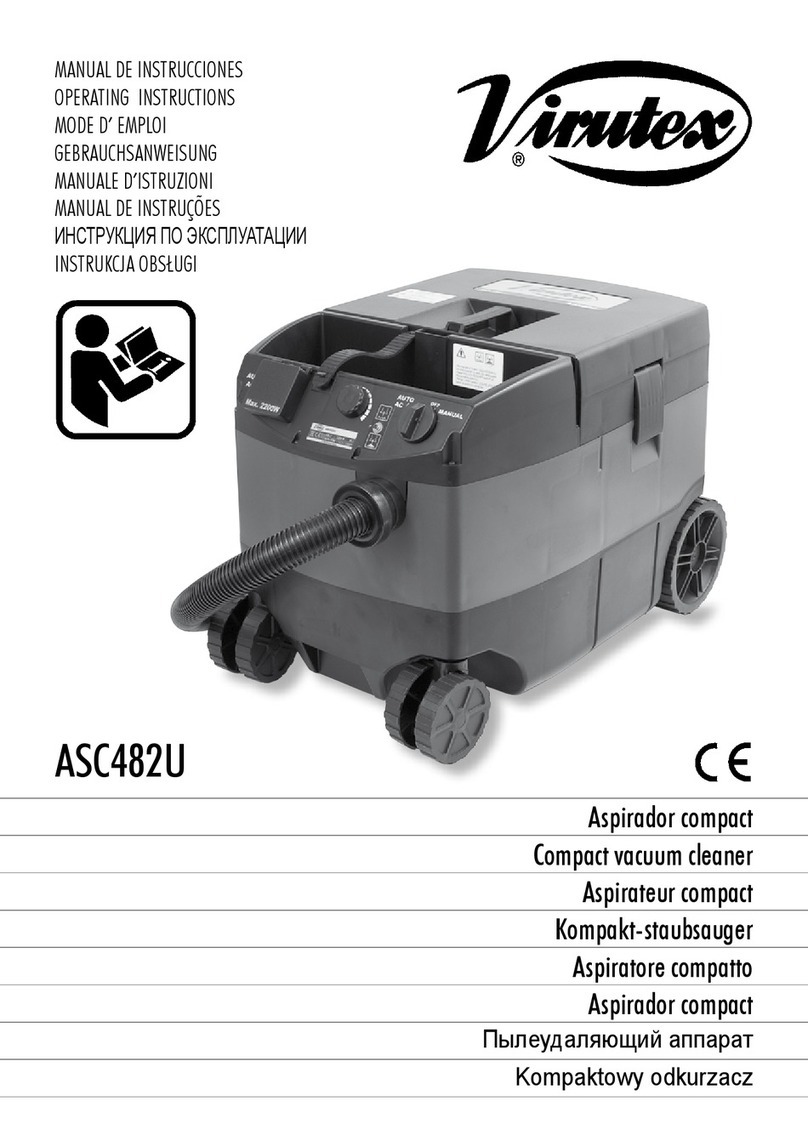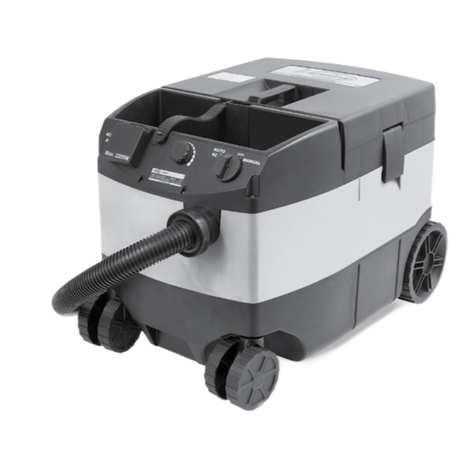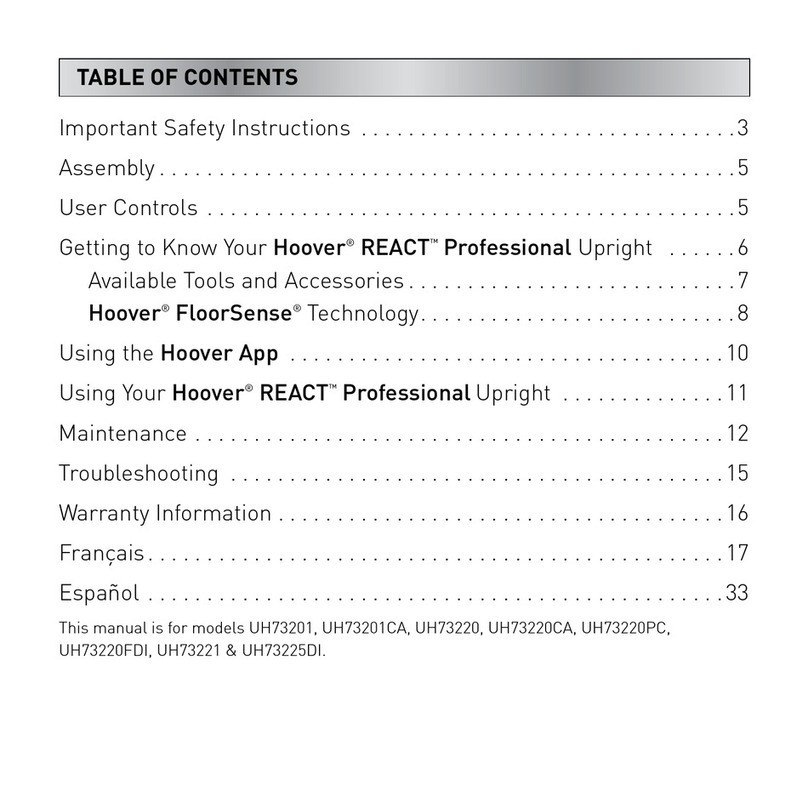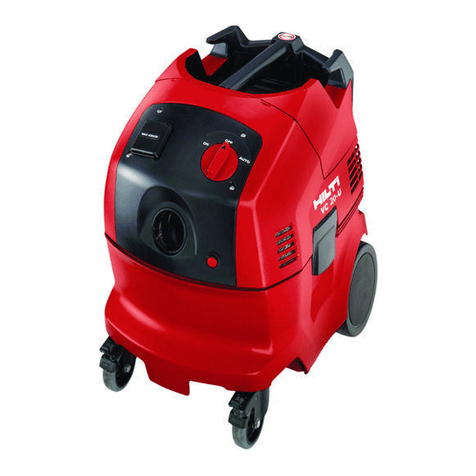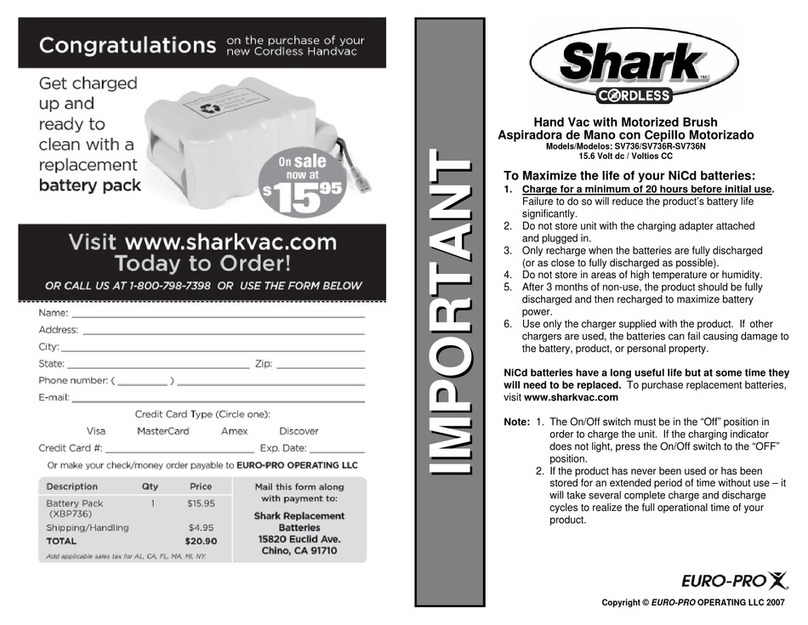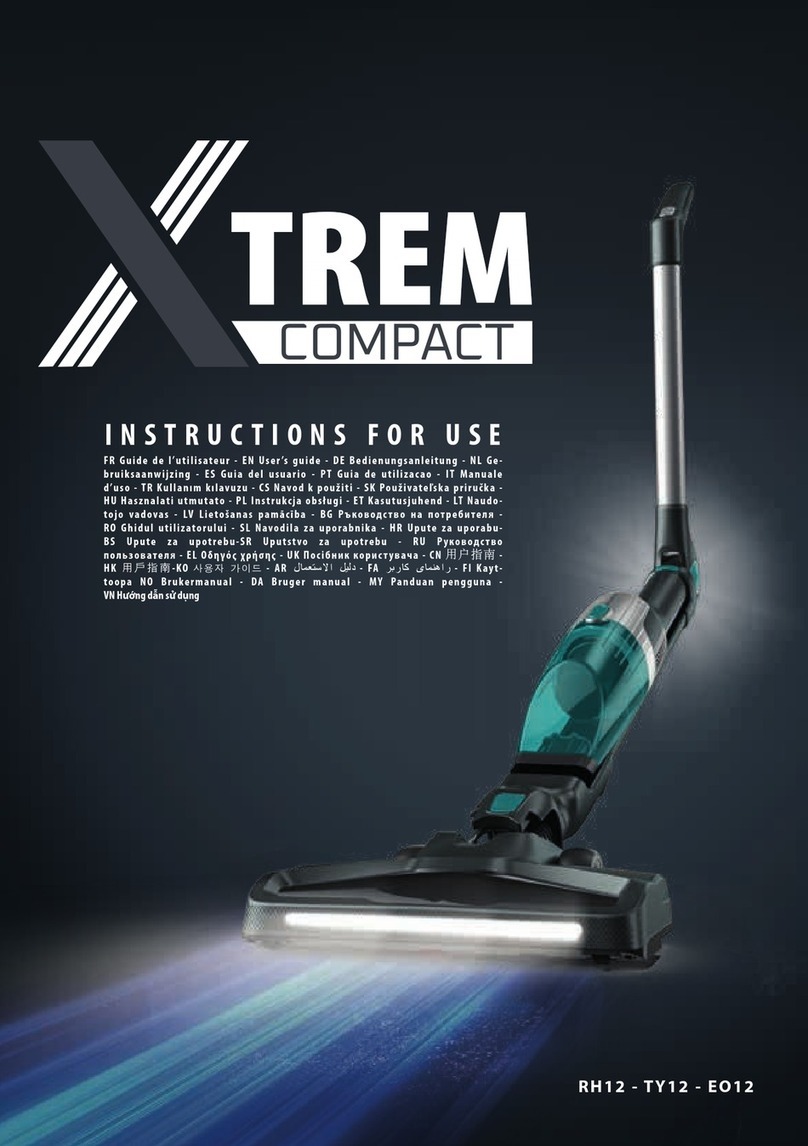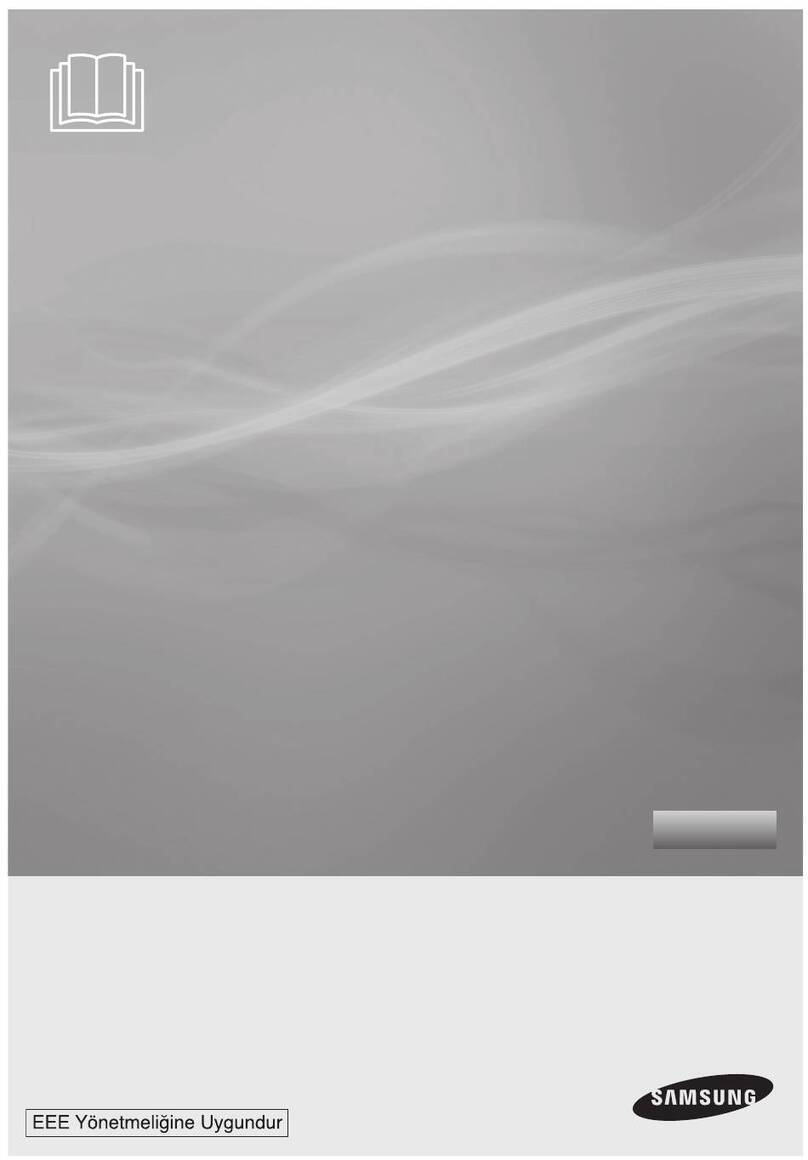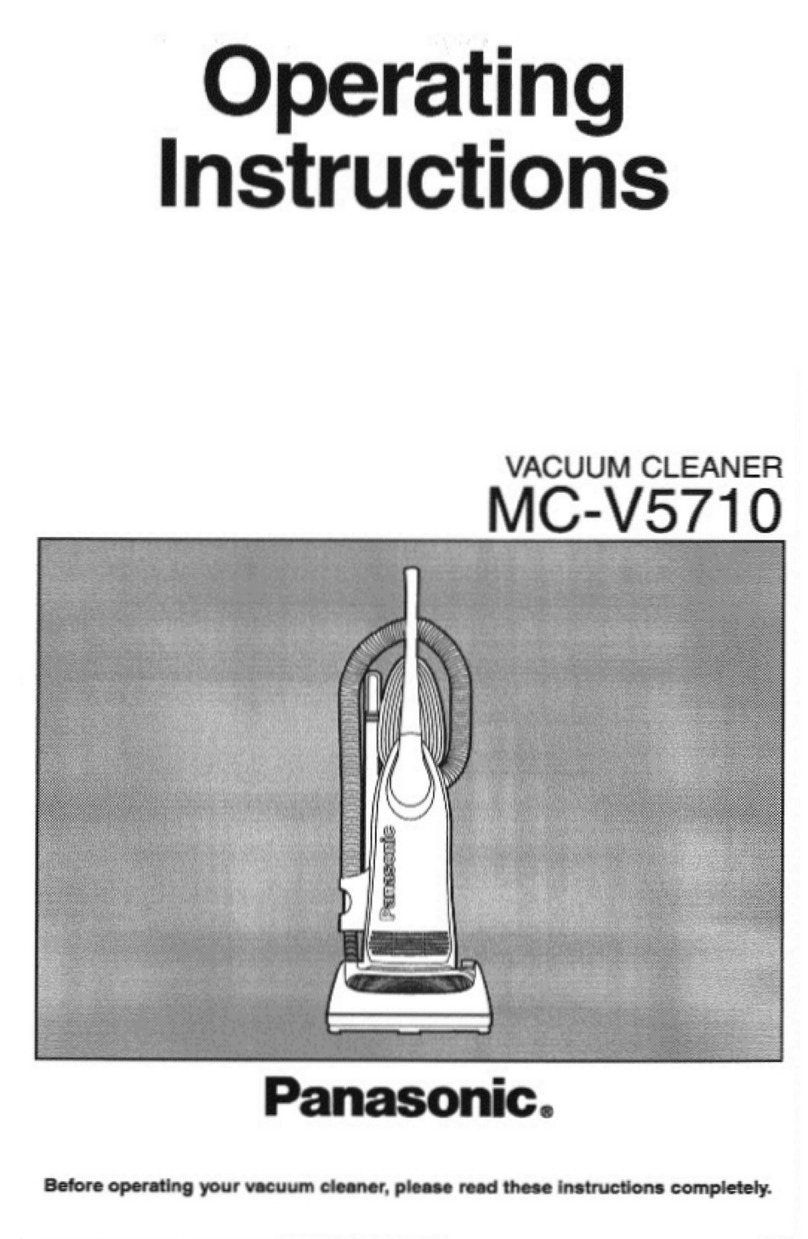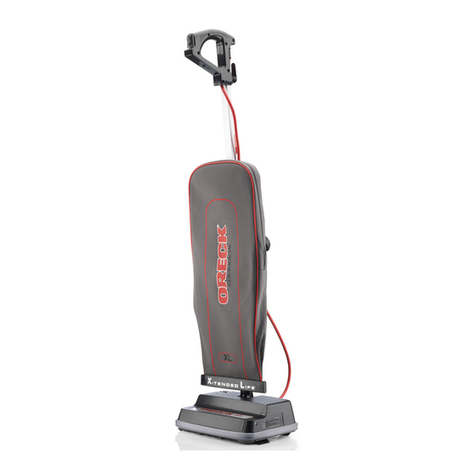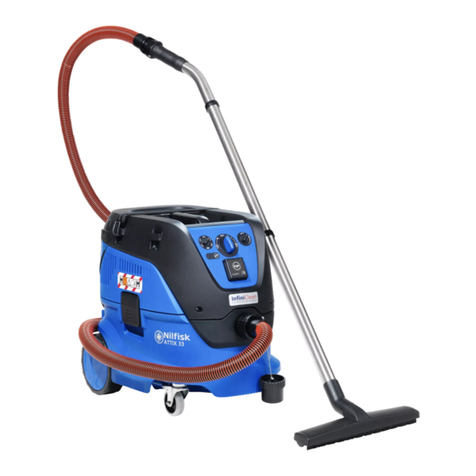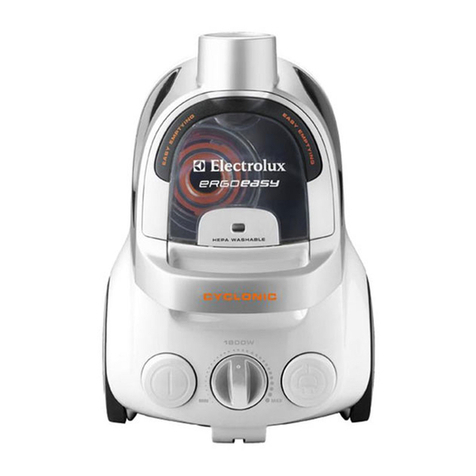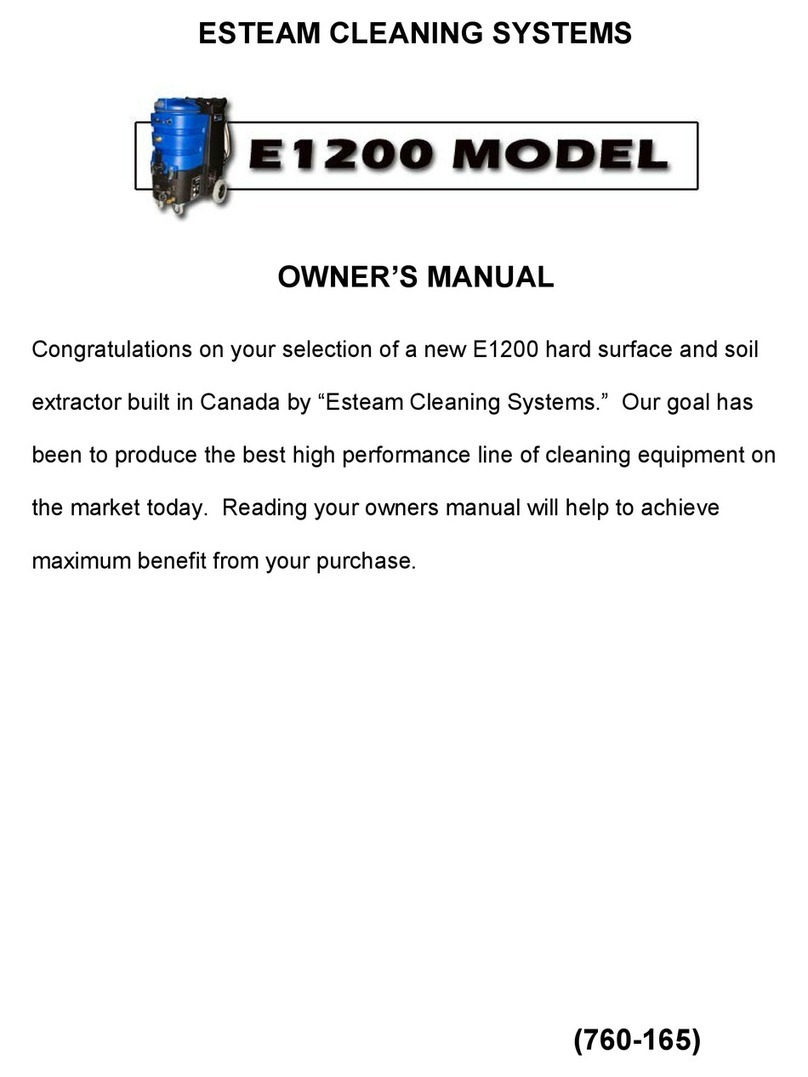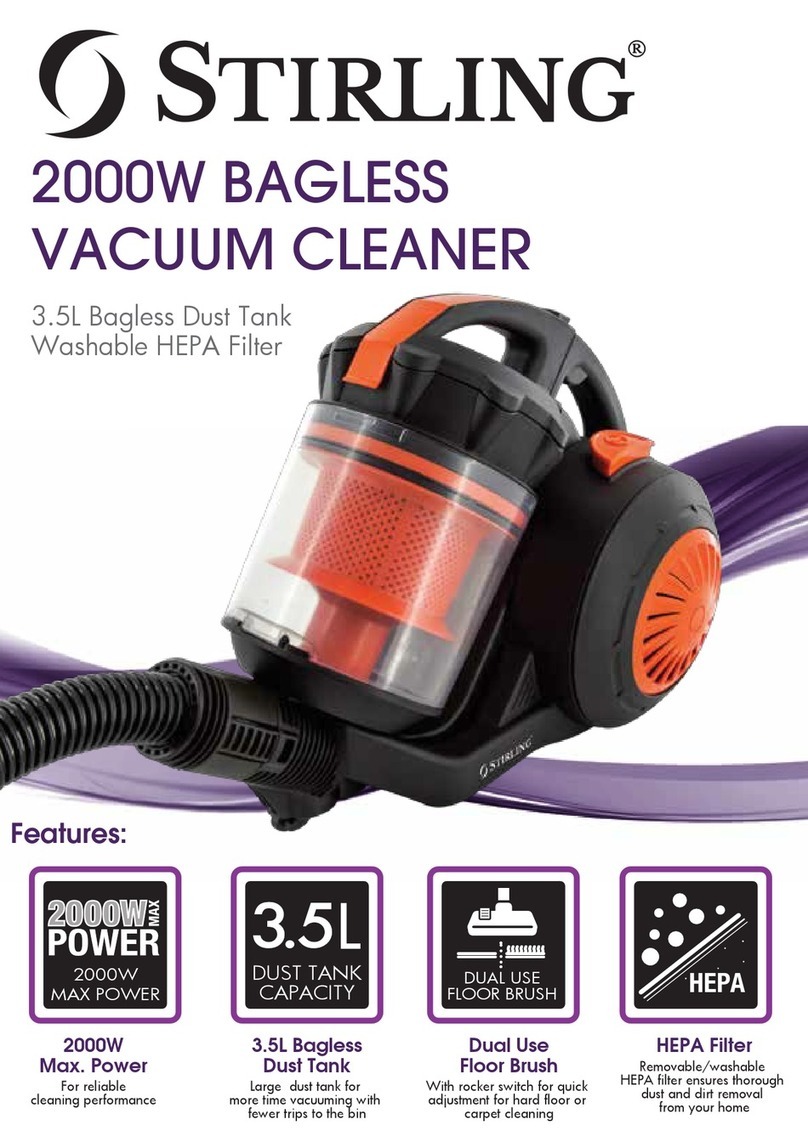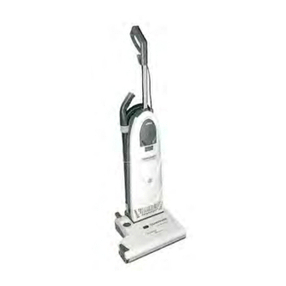Virutex AS800 User manual

Aspirador
Vaccum cleaner
Aspirateur
AS800
MANUAL DE INSTRUCCIONES
OPERATING INSTRUCTIONS
MODE D’EMPLOI

2
ESPAÑOL
ASPIRADOR AS800
Importante
Antes de utilizar la máquina lea atenta-
menteésteMANUALDEINSTRUCCIONES
y el FOLLETO DE INSTRUCCIONES GENE-
RALES DE SEGURIDAD que se adjunta.
Asegúresedehaberloscomprendidoantes
de empezar a operar con la máquina.
Conserve los dos manuales de instruccio-
nes para posibles consultas posteriores.
Antes de conectar el aspirador a la red,
verificar que la tensión de alimentación
sea igual a la indicada en el aspirador.
PARTES PRINCIPALES (Fig. 1 y 2)
1. Bolsa de aspiración
2. Colector
3. Maneta de colocación
4. Fijación bolsa
5. Bolsa de residuos
6. Soporte
7. Ruedas
8. Base
9. Conector de entrada
10. Tapón
11. Unidad de aspiración
12. Conexión de salida del aspirador
13. Abrazadera
14. Tubo de conexión
15. Soporte bolsa aspiración
16. Soporte motor
17. Interruptor principal
18. Motor
Incluye:
- Tubo de 2 metros de PVC flexible
- 2 aros de apriete
- 1 llave Allen
Presentación:
- Su estructura de chapa soldada mecánicamente ase-
gura una buena estabilidad y rendimiento en el trabajo.
- Base con ruedas.
- Motor potente.
-Hélicedeacero remachadopara unamayor resistenciaal
desgaste,aletas perfiladasparaoptimizarelflujo deairey
minimizar el ruido.
- Bolsa de fieltro con capacidad de filtración de 5μ y
bolsa de recolección de plástico (1250 mm de alto).
- Elimine los residuos en un lugar adecuado según la
normativa vigente.
Lospictogramasestánpresentesenlamáquina
yensuembalajepara garantizarsuseguridad.
al usar la máquina. Dada la importancia de
estos símbolos, lea la siguiente información.
Es importante e imperativo que las señales
de seguridad de la máquina permanezcan
legibles y comprensibles, seguir una mayor
eficiencia del aspirador es conveniente lim-
piar los filtros después de cada uso.
MANUAL DE INSTRUCCIONES
OPERATING INSTRUCTIONS
MODE D'EMPLOI
página/page
ESPAÑOL Aspirador AS800
2
ENGLISH Vaccum cleaner AS800
10
FRANÇAIS Aspirateur AS800
18

3
Advertencia de peligro general
Tierra de protección
Lea estas instrucciones
Siempre use protección para los ojos
Siempre use una máscara contra el polvo.
Use siempre protección auditiva
¡Consigue ayuda, lleva dos!
Retire el enchufe de la toma
No deseche herramientas eléctricas, acce-
sorios y embalaje juntos con material de
desecho doméstico
Dispositivo de seguridad (Fig. 3)
Rejilla de protección:
La rejilla (19) protege al usuario del contacto accidental
con la hélice y evita que entren objetos en la unidad
de ventilación. Asegúrese de que la rejilla de protección
esté en buen estado.
Nunca retire el conector de entrada ni limpie la rejilla
mientras la unidad esté encendida o enchufada a la
red eléctrica.
1. INSTRUCCIONES DE SEGURIDAD
1.1 UTILIZAR SEGÚN LAS INDICACIONES
Este dispositivo está diseñado para conectarse a má-
quinas para trabajar la madera con el fin de aspirar
astillas de madera producidas durante la operación.
Trabajar únicamente los materiales para los que ha sido
diseñadoelaspirador.Quedanexcluidos: líquidos,grasas,
partículas finas (yeso, polvo mineral, polvo metálico,
etc.), polvo peligroso.
Eluso noconformealasinstrucciones, lasmodificaciones
realizadasenel aspirador oeluso de piezasnoaprobadas
por el fabricante pueden causar daños irreversibles.
1.2 INSTRUCCIONES GENERALESDE SEGURIDAD
PARA HERRAMIENTAS ELÉCTRICAS
Observe las siguientes instrucciones de
seguridad para eliminar cualquier riesgo
delesiones personales o daños materiales
Peligro debido al entorno de trabajo:
- Este aspirador es solo para uso en interiores y debe
usarse en un suelo nivelado y horizontal.
-Eláreade trabajo debe ser plana ylibredetodo residuo.
- Mantener el puesto de trabajo ordenado.
-Mantente alertayconcentrado entu trabajo,noutilices
eldispositivosi noestáslo suficientementeconcentrado.
Eltrabajodebesercuidadosamente pensado,organizado
y preparado.
- Asegurarse de que la iluminación del puesto de trabajo
sea correcta y suficiente.
-Estedispositivodebeserlo suficientemente potente en
relación con los residuos producidos por la máquina a la
que se conectará (los valores se indican en el capítulo
"Características técnicas" de la máquina).
- Limite al mínimo la cantidad de serrín presente en
el puesto de trabajo: limpie la zona con un aspirador,
controle periódicamente que su aspirador funcione
correctamente y que esté en buenas condiciones. No
sople sobre el serrín presente en la máquina, utilice un
dispositivo de aspiración para la limpieza.
- Trabajar en una habitación suficientemente ventilada.
- Adoptar una posición de trabajo estable y cómoda.
Asegúrese de mantener el equilibrio en todo momento.
- No utilice el dispositivo en presencia de líquidos o
gases inflamables.
- Este dispositivo solo debe ser manipulado, puesto en
funcionamiento y utilizado por personas experimenta-
das que sean conscientes de los peligros presentes. Los
menores solo están autorizados a utilizar el dispositivo
en el marco de una formación profesional y bajo la
supervisión de una persona cualificada.
- Los niños en particular, personas ajenas al aparato en
general, deben mantenerse alejados de la zona de tra-
bajo, y en ningún caso deben tocar el cable eléctrico ni
tampocoelaparatocuandoeste estéenfuncionamiento.
- No sobrepasar las capacidades de trabajo del aparato
(se enumeran en el capítulo ''Características técnicas'').
Peligro por electricidad:
- Este dispositivo no debe exponerse a la lluvia. El área
de trabajo debe estar seca y el aire relativamente poco
cargado de humedad.
- Cuando trabaje con el dispositivo, evite el contacto
del cuerpo con objetos conectados a tierra.
- El cable de alimentación no debe utilizarse para fines
distintos a los que ha sido diseñado.
- Desenchufe el aparato después de su uso.
- Asegúrese de que el aparato esté desenchufado antes
de realizar cualquier mantenimiento, ajuste, servicio,
limpieza…

4
el fabricante. Esto se aplica tanto a las herramientas de
corte como a los dispositivos de seguridad y protección.
- No realice ninguna modificación en las partes del
aparato.
-Cualquier piezaodispositivodeproteccióndañadodebe
serreparado oreemplazadopor unreparador autorizado.
- No utilice el aparato si el interruptor o cualquier parte
del dispositivo eléctrico está defectuoso.
No realice ninguna modificación en el circuito eléctrico.
Haga reparar el dispositivo en un taller especializado
autorizado.
- Antes de comenzar a trabajar, haga funcionar la
máquina vacía. Si nota vibraciones o ruidos anormales,
detenga el aparato y desenchúfelo. No lo reinicies hasta
que hayas resuelto el problema.
Destrucción y eliminación:
- No tire este dispositivo a la basura.
- Recicle esta máquina en los lugares específicamente
destinados a ella: póngase en contacto con las autori-
dades locales o uno de sus representantes para obtener
asesoramiento sobre el reciclaje.
- Garantizar la valorización de las materias primas en
lugar de su eliminación.
- Con el fin de proteger el medio ambiente, los dispo-
sitivos, así como sus accesorios y embalajes, cada uno
debe ser capaz de seguir una ruta de reciclaje adecuada.
1.3 INSTRUCCIONES DE SEGURIDAD ADICIO-
NALES
- Este dispositivo está diseñado solo para uso en seco.
-Este dispositivoestá diseñadosolo parauso eninteriores.
- Coloque el dispositivo sobre una superficie plana,
horizontal, dura y seca.
- Utilice un humidificador si el aire ambiente está dema-
siado seco o si el nivel de humedad es demasiado bajo.
- No aspire ni utilice el aparato en presencia de mate-
riales inflamables.
- El aparato sólo debe ponerse en funcionamiento si
todas las piezas están correctamente instaladas.
- La unidad de ventilación contiene una hélice metálica
que gira a muy alta velocidad y puede causar lesiones
corporales graves: no realice ninguna operación de
limpieza cuando el aparato esté en funcionamiento o
conectado a la red eléctrica.
-Nunca dejequeelaparatofuncionevacío:pareelmotor.
- No limpie el dispositivo ni reemplace las bolsas cuando
el dispositivo esté funcionando: apague el dispositivo y
desenchúfelo de la red eléctrica.
- Colocar el tubo de conexión y el cable eléctrico fuera
de las zonas de tránsito.
- No utilice el dispositivo sin la bolsa de filtración o sin
la bolsa de residuos.
- No se suba en ningún caso a la plataforma del aparato.
- No coloque ni arroje ningún objeto dentro de la unidad
-Lerecomendamos que utiliceundisyuntor de corriente
residual (RCD) FI 30mA.
- ¡Solo los electricistas calificados están autorizados
para trabajar en equipos eléctricos!
Para conectar la máquina a la red eléctrica, consulte el
capítulo 4 (párrafos 4.1 y 4.2).
Peligro por piezas móviles:
- El aparato sólo puede ponerse en marcha cuando
todos los dispositivos de seguridad estén montados
adecuadamente.
- Manténgase a una distancia suficiente del dispositivo
en funcionamiento y de todas las partes móviles.
- Esperar a que la máquina se haya parado por completo
para realizar cualquier operación de limpieza en la zona
detrabajo,incluida lalimpiezade serrín,desechos,restos
de madera, etc.
- Antes de cada puesta en marcha, compruebe que no
quedan herramientas ni repuestos sobre o dentro del
dispositivo.
Peligro por uso:
- Controlar que las piezas de trabajo no contengan
cuerpos extraños (clavos, tornillos, etc.).
- Para evitar cualquier riesgo de enganche y arrastre,
nunca trabaje sobre piezas que contengan cordones,
cables, cintas, hilos, alambres, etc.
Protección personal:
- Llevar protección auditiva.
- Usar gafas protectoras.
Las gafas que usas habitualmente no
brindan protección alguna.
- Use una máscara contra el polvo.
- Llevar ropa de trabajo adecuada.
- No use ropa que pueda engancharse mientras usa el
dispositivo. No use corbatas, guantes o ropa de mangas
sueltas.
- Use una redecilla si tiene el pelo largo.
- Póngase zapatos con suelas antideslizantes.
Peligro por avería de la máquina o modificaciones
inadecuadas:
-Montar eldispositivosegún lasinstrucciones demonta-
je.Todaslaspartesdeben estarcorrectamenteinstaladas.
- Mantenga el aparato y sus accesorios con cuidado
(consulte el capítulo ''Mantenimiento'').
- Antes de cualquier puesta en marcha, asegúrese de
que el aparato esté en buenas condiciones: compruebe
que los dispositivos de seguridad y protección funcio-
nan perfectamente, compruebe que las partes móviles
funcionan correctamente y no se atascan.
- Utilice únicamente piezas de repuesto indicadas por

5
de aspiración.
- Utilizar únicamente bolsas adecuadas: el aspirador
debe llevar siempre una bolsa de filtración de fieltro
superior y una bolsa de recogida inferior de lona o
plástico. El plástico de las bolsas de recuperación debe
ser grueso e irrompible: póngase en contacto con su
distribuidor autorizado.
1.4 ¡ATENCIÓN!
Incluso cuando se siguen todas las instrucciones de
seguridad y la máquina se utiliza según lo previsto,
todavía pueden existir riesgos:
- Contacto con piezas móviles o herramientas.
- Lesiones causadas por materiales voladores o pedazos
de material.
- Riesgo de incendio en caso de ventilación insuficiente
del motor.
- La naturaleza de los productos sobre los que se trabaja
puede provocar la liberación de polvo y partículas que
pueden suponer un riesgo para el usuario, que debe
llevar protección respiratoria adecuada.
- Disminución de la capacidad auditiva al trabajar sin
auriculares con cancelación de ruido.
- Fallo humano (por ejemplo, fatiga corporal excesiva,
situación estresante, etc.)
Es imperativo estar siempre atento durante el trabajo.
2. CARACTERÍSTICAS TÉCNICAS
Tensión........................ Motor monofásico 230 V - 50 Hz
Potencia motor.............................................1500 W – S1
Velocidad de rotación......................................2950 rpm
Dimensiones de la máquina embalada (Largo x
Ancho x Alto)......................920 x 580 x 580 mm
Dimensiones de la máquina lista para usar (Largo
x Ancho x Alto).........................850 x 610 x 1950 mm
Diámetro de la hélice...............................................300 mm
Diámetro entrada ventilador.................................125 mm
Número y diámetro de conexiones...................2x100 mm
Longitud de la manguera flexible.....................2 metros
Velocidad del aire.............................................30,4 m/s
Caudal de aire......................22,4 m3/min o 1344 m3/h
Diámetro de la bolsa...........................................500 mm
Altura de la bolsa de recogida.............................1250 mm
Capacidad de recuperación..............................1x150 litros
Altura de la bolsa de filtro...................................850 mm
Filtración por bolsa..........................................................5 μ
Peso total de la máquina embalada.........................43 Kg
Peso de la máquina lista para usar................................39 Kg
Temperatura ambiente admisible
en funcionamiento...................de +5° a +55°, la tempe-
ratura media del aire ambiente durante un período de
24 horas que no exceda +50°.
Temperatura admisible de
transporte y almacenamiento...................de -25° a +55°
Nivel sonoro medido según ISO 4871:
Nivel de presión sonora LpA...............................83,4 dB(A)
Nivel de potencia sonora LwA............................98,17 dB(A)
Incertidumbre K...........................................................3 dB(A)
¡Utilizar protectores auditivos!
Los valores dados son niveles de emisión y no necesaria-
mente niveles que permitan un trabajo seguro. Aunque
existe una correlación entre los niveles de emisión y los
niveles de exposición, estos no pueden usarse de manera
confiable para determinar si se requieren precauciones
adicionales.
Los parámetros que influyen en los niveles de exposi-
ción reales incluyen las características del taller, otras
fuentes de ruido, etc, es decir, el número de máquinas
y los procesos de fabricación cercanos. Además, los
niveles de exposición permisibles pueden variar de un
país a otro. Sin embargo, esta información permitirá al
usuario de la máquina realizar una mejor evaluación de
los peligros y riesgos.
3. IMPORTANTE
Estedispositivofuncionacomose describeenlas instruc-
ciones de uso. Éstas le permitirán utilizar su dispositivo
de forma rápida y segura:
- Lea todas estas instrucciones de funcionamiento antes
de la puesta en marcha.
- Estas instrucciones de uso están destinadas a personas
con buenos conocimientos básicos sobre el manejo de
dispositivos similares al aquí descrito. Se recomienda
encarecidamente la ayuda de una persona experimen-
tada si no tiene experiencia con este tipo de dispositivo.
- Conserve todos los documentos proporcionados con
este dispositivo, así como el comprobante de compra
para una posible intervención de la garantía.
- El usuario del aparato es el único responsable de
cualquier daño atribuible a un uso no conforme a las
presentes instrucciones de uso, modificación no auto-
rizada de las especificaciones estándar, mantenimiento
inadecuado, daños al aparato o reparación inadecuada
y/o reparación realizada por persona no cualificada.
4. INFORMACIÓN ELÉCTRICA
4.1 INSTRUCCIONES DE CONEXIÓN A TIERRA
En caso de mal funcionamiento o avería, la conexión a
tierra proporciona un camino de menor resistencia para
la corriente eléctrica. Para reducir el riesgo de descarga
eléctrica, esta herramienta está equipada con un cable
eléctrico que tiene un conductor de conexión a tierra
del equipo y un enchufe con conexión a tierra.
-El enchufedebeconectarseaunatomacorrespondiente
que esté correctamente instalada y conectada a tierra
de acuerdo con las normas europeas vigentes.

6
- No modifique el enchufe suministrado; si no encaja
en la tomacorriente, haga que un electricista calificado
instale el tomacorriente adecuado.
- La conexión incorrecta del cable de puesta a tierra
puede provocar descargas eléctricas. El cable aislado
verde(cono sin rayasamarillas)es el conductordetierra.
Si es necesario reparar o reemplazar el cable eléctrico
o el enchufe, no conecte el cable de conexión a tierra
del equipo a un enchufe.
Consulte a un electricista o técnicos cua-
lificados si tiene dudas o si no comprende
las instrucciones de conexión a tierra.
Entodoslos casos, asegúresedequela toma
de pared a la que conecta su máquina esté
correctamenteconectadoatierra.Encaso
deduda,llamea un electricista cualificado.
Esta máquina está diseñada solo para
uso en interiores.
- Proteger el motor contra las salpicaduras de agua.
- El cable de alimentación no debe utilizarse para fines
distintos a los que ha sido diseñado.
Comprobar periódicamente su estado.
- Si la máquina se desconecta por sobrecarga, reactivar
el interruptor solo después de 60 segundos.
En un período de 10 minutos, no active el interruptor
más de 5 veces.
- Tensión de entrada 230 V - 50 Hz, Fusible 20 A,
- Utilizar un cable eléctrico con una sección mínima
de 2,5 mm2.
4.2 USO DE CABLES DE EXTENSIÓN
-Utilice únicamentealargos detrescablescuyosenchufes
correspondan al enchufe de la herramienta como se
muestra en la figura siguiente.
- Repare o reemplace inmediatamente los cables des-
gastados o dañados.
- La extensión no debe exceder en ningún caso una
longitud de 10 metros.
- Asegúrese de que su cable de extensión esté en buenas
condiciones cuando lo use y que esté correctamente
conectado.
- Asegúrese de que esté bien calibrado en relación con
la potencia de su máquina.
El uso de un cable de extensión de tamaño insuficiente
provocará una pérdida de energía y un sobrecalenta-
miento.
- Proteja sus cables de extensión y manténgalos alejados
de objetos afilados, fuentes de calor excesivo y lugares
mojados o húmedos.
- Utilice un circuito eléctrico separado para sus herra-
mientas.Antesde enchufar laherramienta,asegúrese de
que el voltaje del circuito sea el mismo que se muestra
en la placa de identificación. Hacer funcionar la herra-
mienta a un voltaje más bajo o más alto dañará el motor.
5. DESEMBALAJE Y MONTAJE DE LA MÁQUINA
En ningún caso se debe conectar la
máquina a la red eléctrica mientras se
realicen estos procesos: asegúrese de que
el aspirador esté desenchufado.
5.1 DESEMBALAJE Y CONFIGURACIÓN DE LA
MÁQUINA (Fig. 4)
- La máquina se entrega en un embalaje de car-
tón: se puede cargar, descargar y mover fácilmente
usando una transpaleta o montacargas.
- Elija la ubicación teniendo en cuenta las capacidades
de la máquina y los movimientos que deberá realizar
antes, durante y después del trabajo.
La superficie debe ser sólida, estable, seca, plana y
horizontal.
La máquina embalada pesa más de 40
kg: no manipule la caja solo y es impres-
cindible que obtenga la ayuda de una o
más personas.
• Preste atención al riesgo de vuelco.
• Verifique que todas las partes móviles
de la máquina estén seguras antes de
levantarla y moverla.
• Verifique que la máquina esté bien
asegurada antes de levantarla y moverla.
- Al recibirla, desembale cuidadosamente la máquina y
asegúrese de que no haya sufrido ningún daño durante
el transporte y que todas las piezas estén en la caja de
embalaje.
En caso de pérdida o anomalía, póngase en contacto
con su distribuidor rápidamente.
- Retire todas las protecciones de plástico.
- Guarde todos los materiales de embalaje hasta que
haya inspeccionado y utilizado la herramienta satis-

7
factoriamente.
El dispositivo viene parcialmente ensamblado.
Los siguientes componentes deben instalarse antes de
iniciar el dispositivo:
- Carcasa filtración (A)
- Tubo de conexión a la máquina (B)
- Tubo de conexión aspirador/colector (C)
- Ventilador y motor (D)
- Soporte motor (E)
- Adaptador de salida con junta de goma (F)
- Ruedas de transporte (G)
- Adaptador de entrada (H)
- Placa base (I)
- Tapón (J)
- Soportes (K)
- Soporte bolsa de filtración (L)
- Bolsa de filtración (M)
- Bolsa de recuperación (N)
5.2 MONTAJE DE LA PLACA BASE (Fig. 5 y 6)
Herramientas necesarias: 1 destornillador + 1 llave de
10 mm (no incluida).
Compruebe la planitud del suelo. El dis-
positivo debe ser absolutamente estable.
- Colocar la placa (21) de canto.
- Coloque los rodillos (22) debajo de la mesa y asegúrelos
con 4 conjuntos de tornillos de cabeza cruzada M6x10 /
arandela / tuerca M6 (23) cada uno: inserte los tornillos
desde arriba de la mesa, luego las arandelas y tuercas
desde abajo.
- Apretar bien los tornillos y tuercas (23) y luego dar la
vuelta a la placa (21).
5.3 MONTAJE EN LA PLACA BASE (Fig. 7 a 10)
Herramienta necesaria: 1 llave de 13 mm (no incluida).
No transporte el motor solo: ¡obtenga
ayudaparalevantarlo,moverlo ycolocarlo
- Colocar el soporte motor (24) sobre la placa (25) (Fig.
7) y atornillarlo directamente en la placa con los 4
tornillos hexagonales M8x16 y las arandelas (26) (Fig. 8).
- Con la ayuda de una tercera persona, coloque el
conjunto ventilador/motor (27) sobre la placa (25): el
motor debe apoyarse en el soporte (24) y los soportes
de montaje del ventilador deben colocarse en los 2
orificios (28) (Figs. 7 y 8).
- Ajuste la posición del ventilador (27) y luego asegúrelo
con 2 juegos de tornillos / arandelas hexagonales M8x16
(29)queatornillará directamente enlaplaca(25) (Fig. 9).
- Regular la posición del motor (27) y luego fijarlo en
su soporte (24) con 4 juegos de tornillos hexagonales
M8x25 / arandelas / tuerca M8 (30) (Fig. 10).
5.4 MONTAJE DEL ADAPTADOR DE SALIDA
(Figs. 11 a 17)
Herramientas necesarias: 1 llave de 10 mm + 1 llave de
13 mm (no incluidas).
- Colocar la junta (31) en la salida del ventilador (32)
(Fig. 11).
- Luego coloque el conector de salida (33) posicionando
correctamentela junta(31),luego asegúrelocon 6juegos
de tornillos hexagonales M6x20/arandelas/tuercas M6
(34) (Fig. 12).
- Posicionar los soportes del colector (35) y fijarlos con
2 juegos de tornillos hexagonales M8x16 cada uno /
arandela (36) que enroscarás directamente en la placa
(37) (Fig. 13).
Tenga cuidado de orientar correctamente los soportes
(35) de forma que las orejetas de fijación del colector
queden orientadas hacia el interior de la placa (Fig. 14).
No instale la carcasa de filtrado solo:
¡obtengaayudaparalevantarlo,colocarlo
y asegurarlo!
-Conla ayudadeuna tercerapersona, coloquelacarcasa
de filtración (38) en la parte superior de los soportes
(35) dirigiendo la entrada (39) de la carcasa de filtración
hacia el conjunto motor/ventilador (Fig. 15).
- Fije la carcasa de filtración (38) en los 2 soportes exter-
nos (35) con por cada 2 juegos de tornillos hexagonales
M8x16 / arandela (40) que atornillará directamente en
la carcasa de filtración (Fig. 16).
- Posicionar el estribo soporte bolsa filtrante (41) sobre
el estribo soporte central (35) (Fig. 17).
- Atornillar todo directamente a la carcasa de filtración
(38) con 2 juegos de tornillos/arandelas hexagonales
M8x16 (40).
5.5 MONTAJE DEL TUBO FLEXIBLE Ø 125 mm
(Fig. 18 y 19)
Herramienta necesaria: 1 llave de 10 mm o 1 destorni-
llador plano (no suministrado).
- Colocar una de las 2 abrazaderas (42) en un extremo
del tubo de Ø 125 mm (43) (Fig. 18).
- Montar el tubo (43) en el conector de salida del ven-
tilador (44), luego apretar el collarín (42).
- Colocar el segundo collarín (42) en el otro extremo
del tubo de Ø 125 mm (43) (Fig. 19).
- Montar el tubo (43) en la entrada del colector (45) y
luego apretar el collarín (42).

8
5.6 MONTAJE DEL CONECTOR DE ENTRADA Y
TUBO FLEXIBLE (Fig. 20 y 21)
Herramientasnecesarias:1destornillador + 1 llavede10
mm o 1 destornillador plano (no suministrado).
- Montar el conector (46) en la entrada del ventilador
(47) y fijarlo con el tornillo (48) (Fig. 20).
- Colocar el tapón ciego (49) en una de las dos entradas
del conector (46).
Siuna delasdosentradas(46)delaspiradorno
está conectada a una máquina, es imprescin-
dible colocar el tapón ciego (49) en la misma.
- Colocar una de las 2 abrazaderas (50) en un extremo
del tubo de Ø 100 mm (51) (Fig. 21).
- Montar el tubo (51) en una de las dos entradas del
conector (52) y luego apretar el collarín (50).
5.7 MONTAJE DEL ASA DE TRANSPORTE (Fig. 22)
Herramienta necesaria: 1 llave Allen.
- Coloque la palanca de desplazamiento (53) a la de-
recha del colector (54), luego fíjela con los 2 tornillos
de cabeza hueca (55) que atornillará directamente en
el colector (54).
5.8 INSTALACIÓN DE LAS BOLSAS (Fig. 23 a 26)
5.8.1 BOLSA DE RECUPERACIÓN (Fig. 23 y 24)
- Colocar correctamente la bolsa de residuos (58) en la
parte inferior de la carcasa de filtración (59).
Nota: Para facilitar la operación, sostenga la bolsa en el
colector con cinta adhesiva en varios lugares.
- Coloque la correa de flejado (56) sobre el cordón
de retención, coloque el gancho de la correa en el
garrasdesujeción yapretarbajando laempuñadura (60).
-Controlar quelaestanqueidaddela bolsaseasuficiente;
ajuste la tensión de la correa si es necesario.
5.8.2 BOLSA DE FILTRACIÓN (Fig. 25 y 26)
- Colgar la bolsa filtro (61) en el gancho del soporte (62).
- Inserte la correa de sujeción (56) dentro del dobladillo
de la bolsa de filtro (61).
- Colocar correctamente la bolsa (61) en la parte supe-
rior del colector (59), debajo del reborde de retención.
- Introducir el gancho de la correa en las garras de
sujeción y apretar bajando la empuñadura (60).
-Controlar quelaestanqueidaddela bolsaseasuficiente;
ajuste la tensión de la correa si es necesario.
6. PUESTA EN MARCHA
6.1 CONEXIÓN A UNA MÁQUINA (Fig. 27)
Herramienta necesaria: 1 llave de 10 mm o 1 destorni-
llador plano (no suministrado).
El polvo en general puede ser nocivo para
la salud y puede, en caso de contacto o
inhalación, provocar alergias o enferme-
dades respiratorias, tanto para el usuario
como para las personas del entorno.
Tome todas las precauciones necesarias para proteger
su salud, especialmente en un ambiente que contenga
pinturas con plomo y ciertas maderas. El polvo de ciertas
maderas (roble, fresno, haya, por ejemplo) se considera
cancerígeno.
- Use una máscara contra el polvo para evitar inhalar
el polvo en el aire.
- Comprobar que la máquina esté equipada con un
manguito de extracción de 100 mm de diámetro. De lo
contrario, utilice un adaptador adecuado.
- Utilice una manguera adecuada para conectar la
aspiradora a la máquina.
-Comprobar queel tubode conexiónestéenbuenestado.
- Verificar que las propiedades del dispositivo de ex-
tracción de virutas correspondan a los requisitos de
la máquina.
- Siga las instrucciones de uso de la máquina a la que
está conectada la aspiradora.
- Colocar el segundo collarín (63) en el otro extremo
del tubo de Ø 100 mm (64).
- Montar el tubo (64) en el manguito de extracción (65)
de la máquina, luego apretar el collarín (63).
Recordatorio: Debe colocar un tapón ciego en la boca
del conector no conectado a una máquina.
6.2 CONEXIÓN A LA RED
Peligro de descarga eléctrica.
- Utilice el dispositivo únicamente en un entorno seco.
- Verificar periódicamente el estado del cable eléctrico
y del enchufe.
- Utilice únicamente cables aislados con una sección
transversal suficiente como prolongaciones.
- Coloque el cable eléctrico de manera que no le moleste
durante su trabajo y no pueda ser estropeado.
- Proteger el cable eléctrico de cualquier factor que
pueda dañarlo (calor, aristas vivas, líquidos corrosivos
o agresivos, etc.)
- Conectar el aparato únicamente a una toma de
corriente que cumpla con las normas vigentes y las

9
características de la aspiradora: tensión y frecuencia de
red correspondientes a las mencionadas en la placa de
características de la máquina, protección por disyuntor
diferencial, tomas debidamente instaladas, puestas a
tierra y comprobado.
-Notirardel cable eléctrico para desconectarelenchufe
de la toma.
6.3 PRIMEROS PASOS (Fig. 28)
Realice todos los ajustes antes de encen-
der el dispositivo. No haga ningún ajuste
mientras el ventilador esté funcionando.
Mantenga siempre las manos alejadas
del ventilador.
- Verificar antes de cualquier operación que los dispo-
sitivos de seguridad y protección estén en buen estado.
- Antes de la puesta en marcha, asegúrese de que no
haya objetos sobre la aspiradora o sobre su base.
- No aspirar piezas metálicas ni polvo: la proyección de
chispas o fragmentos metálicos incandescentes puede
provocar un incendio.
- Usar equipo de protección personal: gafas, mascarilla
antipolvo, casco auditivo, calzado con suela antides-
lizante.
- Durante el mecanizado, nunca manipule los tubos
flexibles, las abrazaderas, las correas: pare la máquina
y desconéctela de la red eléctrica.
- Presione el botón interruptor verde marcado "I" (68)
para poner en marcha la aspiradora.
- Pare el aparato presionando el botón rojo marcado
"O" (69).
7. MANTENIMIENTO
Antesdecualquieroperaciónde manteni-
miento o limpieza, desconecte el enchufe
eléctrico de la red. La máquina no debe
encenderse bajo ninguna circunstancia.
El trabajo de mantenimiento y servicio que se describe
a continuación puede realizarlo usted mismo.
Los trabajos de mantenimiento y servicio que no sean
los descritos en este capítulo deben ser realizados por
personal cualificado.
- Realice un mantenimiento regular para evitar la
aparición de problemas no deseados.
El uso de piezas no probadas o no aprobadas por el
fabricante puede causar accidentes o daños personales.
- Comprobar el correcto funcionamiento de todos los
dispositivos de protección y seguridad después de cada
operación de mantenimiento.
7.1 CAMBIO DE BOLSAS
Use una mascarilla adecuada para evitar
inhalar el polvo en el aire.
Consulte el párrafo 5.8 "Instalación de las bolsas".
- Sustituya la bolsa de recogida de virutas tan pronto
como esté llena: sustitúyala por una bolsa nueva.
- Reemplace la bolsa de filtro regularmente.
- Examinar periódicamente el estado de las bolsas.
Asegúrese de que no haya rasgaduras ni agujeros, y que
las bolsas estén bien sujetas con la correa de sujeción.
- Reemplace las bolsas gastadas o dañadas.
7.2 CAMBIO DEL TUBO ASPIRACIÓN
Herramienta necesaria: 1 llave de 10 mm o 1 destorni-
llador plano (no suministrado).
Use una mascarilla adecuada para evitar
inhalar el polvo en el aire.
Consulte el apartado 6.1 “Conexión a una máquina”.
- Controlar periódicamente el estado de la tubería de
aspiración. Asegúrese de que no haya rasgaduras ni
agujeros, y que las abrazaderas sujeten la manguera
de forma segura.
- Reemplace la manguera desgastada o dañada por
una nueva.
7.3 LIMPIEZA DEL DISPOSITIVO
Realice una limpieza a fondo después de cada uso para
evitar la acumulación de serrín, polvo u otros residuos
en los elementos vitales de la máquina. La limpieza
inmediata evitará la formación de grumos de residuos
que le serán más difíciles de eliminar posteriormente y,
sobre todo, evitará la aparición de restos de corrosión.
- El dispositivo debe estar limpio para realizar un
trabajo eficaz.
- El aparato debe mantenerse limpio para evitar su
deterioro y desgaste prematuro.
-Lasranuras deventilacióndel motordebenmantenerse
limpias para evitar el sobrecalentamiento.
- Quitar virutas, serrín, polvo y restos de madera con
aspiradora, cepillo o brocha.
- Limpiar elementos de mando, reguladores, ranuras de
ventilación del motor.
- Eliminar los restos de resina con un spray limpiador
adecuado.
- No utilizar agua, detergentes, productos abrasivos
o corrosivos.

10
7.4 MANTENIMIENTO
Antes de cada uso:
- Comprobar que el cable eléctrico y el enchufe de
conexión estén en buen estado. Haga que una persona
calificada los reemplace si es necesario.
- Verificar que todas las partes móviles y todos los dis-
positivos de seguridad y protección del aparato estén
en buen estado de funcionamiento.
- Encienda el dispositivo y asegúrese de que no haya
ruidos sospechosos o vibraciones anormales, especial-
mente a nivel del ventilador. Si este es el caso, apague el
dispositivo,desenchúfelo delared eléctricaysolo vuelva
a encenderlo una vez que se haya resuelto el problema.
Regularmente, dependiendo de la frecuencia de uso:
- Comprobar todos los tornillos y volver a apretarlos
si es necesario.
- Verificar el estado de las bolsas y mangueras flexibles:
cambiarlas si es necesario.
- Verificar el estado de los soportes del grupo de ven-
tilación y cambiarlos si es necesario.
7.5 ALMACENAMIENTO
En ningún caso se debe almacenar la
máquina conectada a la red eléctrica:
desconectar el enchufe de alimentación
de la máquina de la red eléctrica.
- Desconecte el enchufe de alimentación del aspirador
de la red eléctrica.
- Guarde el aspirador de tal manera que no pueda ser
puesto en marcha por una persona no autorizada.
- Guarde el aspirador de forma que nadie pueda ha-
cerse daño.
-No dejeelaspiradoralaire libre,no loguardeenunlugar
húmedo: guárdelo en un lugar protegido y cuarto seco.
- Tenga en cuenta la temperatura del lugar donde se
almacena el aspirador (consulte el capítulo "Especifi-
caciones técnicas").
8. GARANTÍA
Todas las máquinas electroportátiles VIRUTEX, tienen
una garantía válida de 12 meses a partir del día de su
suministro,quedandoexcluidastodaslasmanipulaciones
o daños ocasionados, por manejos inadecuados o por
desgaste natural de la máquina. Para cualquier repara-
ción, dirigirse al servicio oficial de asistencia VIRUTEX.
9.RECICLAJEDELASHERRAMIENTAS ELÉCTRICAS
Nunca tire la herramienta eléctrica con el resto de resi-
duos domésticos. Recicle las herramientas, accesorios y
embalajes de forma respetuosa con el medio ambiente.
Respete la normativa vigente de su país.
Aplicable en la Unión Europea y en países europeos
con sistemas de recogida selectiva de residuos:
La presencia de esta marca en el producto o en el
material informativo que lo acompaña, indica que al
finalizar su vida útil no deberá eliminarse junto con
otros residuos domésticos.
ConformealaDirectivaEuropea 2002/96/CElosusuarios
puedencontactar conel establecimientodonde adquirie-
ronel producto,oconlasautoridades localespertinentes,
para informarse sobre cómo y dónde pueden llevarlo
para que sea sometido a un reciclaje ecológico y seguro.
VIRUTEXsereservaelderecho demodificarsus productos
sin previo aviso.
ENGLISH
VACCUM CLEANER AS800
Important
Read these OPERATING INSTRUCTIONS
and the attached GENERAL SAFETY
INSTRUCTIONS LEAFLET carefully before
using the machine. Make sure you have
understood them before operating the
machine for the first time.
Keep both sets of instructions for any
future queries.
Before connecting the aspirator to the
mains ensure that the voltage is the same
as that on the aspirator.
1. PROFILE OF THE MACHINE (Fig. 1 & 2)
1. Filtration bag (felt)
2. Filtration housing
3. Handle
4. Retaining strap
5. Collector bag (plastic)
6. Filtration housing support rod
7. Castor wheel
8. Base plate
9. Inlet adaptor

11
10. Inlet adaptor cover
11. Fan assembly
12. Outlet adaptor
13. Hose clamp (Ø125)
14. Flexible hose Ø125 mm
15. Upper bag support rod
16. Main switch
17. Motor support bracket
18. Motor unit
It includes:
- 2 m flexible hose Ø100 mm
- 2 hose clamps (Ø100)
- 1 hex key
Presentation:
- Its mechanically welded sheet metal structure ensures
good stability and work performance.
- Base with wheels.
- Powerful engine.
- Riveted steel propeller for greater resistance to wear,
profiled fins to optimize airflow and minimize noise.
- Felt bag with filtration capacity of 5μ and plastic
collection bag (1250 mm diameter) high.
- Dispose of waste in a suitable place according to the
regulations in force.
Some pictograms are present on the
machine and its packaging in order to
guarantee your safety
when using the machine. Given the im-
portance of these symbols, please read
the following information carefully.
It is important and imperative that the
safety warnings on the machine remain
legible and understandable.
Warning: danger
Machine must be Earth grounded
Read and understand the instruction manual
before using the machine
Wear eye protection
Wear dust mask
Wear ear protection
Ask for help to handle the machine!
Remove the plug out of the socket before
setting, maintenance, or cleaning
operations.
Do not dispose of electric tools together
with household waste material
Safety devices (Fig. 3)
The safety guard grill:
Thesafetyguard grill(19)prevents accidentalpassageof
anyobjectinto theventilationunit andthusprotects the
user from an accident due to the fan damage. DO NOT
modify the safety guard grill.
NEVER clean the safety guard grill when the machine
is switched on or connected to the mains.
1. SAFETY INSTRUCTIONS
1.1 USE AS INDICATED
This device is designed to connect to machines to work
wood in order to vacuum wood chips produced during
the operation.
Work only the materials for which it has been designed
thevacuumcleaner. Excluded:liquids,fats, fineparticles
(gypsum, mineral dust, metal dust, etc.), hazardous dust.
Use not in accordance with the instructions, modifi-
cations performed on the vacuum cleaner or the use
of non-approved parts by the manufacturer can cause
irreversible damage.
1.2 GENERAL SAFETY INSTRUCTIONS
Observe las siguientes instrucciones de
seguridad para eliminar cualquier riesgo
delesiones personales o daños materiales
Danger due to the working environment:
- This vacuum cleaner is for indoor use only and must
be used on a level and horizontal floor.
- The work area must be flat and free of all debris.
- Keep the workplace tidy.
- Stay alert and focused on your work, do not use the
device if you are not focused enough. The work must be
carefully thought out, organized and prepared.
- Make sure that the lighting in the workplace is correct
and sufficient.
- This device must be powerful enough in relation to
the waste produced by the machine to which it will be
connected (the values are indicated in the "Technical
characteristics" chapter of the machine).

12
- Limit the amount of sawdust present in the workplace
to a minimum: clean the area with a vacuum cleaner,
periodically check that your vacuum cleaner works
correctly and that it is in good condition.
Do not blow on the sawdust present in the machine,
use a suction device for cleaning.
- Work in a sufficiently ventilated room.
- Adopt a stable and comfortable working position.
Be sure to keep your balance at all times.
- Do not use the device in the presence of flammable
liquids or gases.
- This device must only be handled, put into operation
and used by experienced persons who are aware of the
dangers present. Minors are only allowed to use the
device within the framework of professional training
and under the supervision of a qualified person.
-Children inparticular,peopleunrelatedtotheappliance
in general, must be kept away from the work area, and
in no case should they touch the electrical cable or the
appliance when it is in operation.
- Do not exceed the working capacities of the appliance
(listed in the ''Technical characteristics'' chapter).
Peligro por electricidad:
- Este dispositivo no debe exponerse a la lluvia. El área
de trabajo debe estar seca y el aire relativamente poco
cargado de humedad.
- Cuando trabaje con el dispositivo, evite el contacto
del cuerpo con objetos conectados a tierra.
- El cable de alimentación no debe utilizarse para fines
distintos a los que ha sido diseñado.
- Desenchufe el aparato después de su uso.
- Asegúrese de que el aparato esté desenchufado antes
de realizar cualquier mantenimiento, ajuste, servicio,
limpieza…
-Lerecomendamos que utiliceundisyuntor de corriente
residual (RCD) FI 30mA.
- ¡Solo los electricistas calificados están autorizados
para trabajar en equipos eléctricos!
Para conectar la máquina a la red eléctrica, consulte el
capítulo 4 (párrafos 4.1 y 4.2).
Moving Parts Hazard:
- The appliance can only be started when all safety
devices are properly installed.
- Keep a sufficient distance from the device in operation
and from all moving parts.
- Wait until the machine has come to a complete stop
to carry out any cleaning operation in the work area,
including cleaning sawdust, debris, wood remains, etc.
- Before each start-up, check that there are no tools or
spare parts left on or inside the device.
Danger by use:
- Check that the work pieces do not contain foreign
bodies (nails, screws, etc.).
- To avoid any risk of being caught and dragged, never
work on parts that contain cords, cables, tapes, threads,
wires, etc.
Personal protection:
- Wear hearing protection.
- Wear protective glasses.
The glasses you usually wear do not
provide any protection.
- Wear a dust mask.
- Wear suitable work clothes.
- Do not wear clothing that could get caught while
using the device. Do not wear ties, gloves, or looses-
leeved clothing.
- Wear a hairnet if you have long hair.
- Wear shoes with non-slip soles.
Dangerdue tomachine failureorimpropermodifications:
-Assemblethe deviceaccordingto theassembly instruc-
tions. All parties must be correctly installed.
- Maintain the appliance and its accessories with care
(see the ''Maintenance'' chapter).
- Before any start-up, make sure that the appliance is
in good condition: check that the safety and protection
devicesworkperfectly,checkthat themovingparts work
correctly and do not get stuck.
- Only use spare parts indicated by the manufacturer.
This applies to both cutting tools and safety and se-
curity devices.
- Do not make any modifications to the parts of the
appliance.
-Any damagedpart orprotection devicemustberepaired
or replaced by an authorized repairer.
- Do not use the appliance if the switch or any part of
the electrical device is faulty.
Donotmakeanymodificationstotheelectricalcircuit.Have
thedevicerepaired atanauthorized specialistworkshop.
-Beforestartingwork,run themachineempty. Ifyou no-
ticeabnormal vibrationsornoises,stopthe applianceand
unplugit.Donotrestartituntilyouhaveresolvedtheissue.
Destruction and disposal:
- Do not throw this device away.
- Recycle this machine in places specifically designated
for it: contact the local authorities or one of their
representatives for advice on recycling.
- Guarantee the recovery of raw materials instead of
their elimination.
- In order to protect the environment, the devices, as
well as their accessories and packaging, each must be
able to follow a proper recycling route.
1.3 ADDITIONAL SAFETY INSTRUCTIONS
- This device is designed for dry use only.

13
- This device is designed for indoor use only.
- Place the device on a flat, horizontal, hard and dry
surface.
- Use a humidifier if the room air is too dry or if the
humidity level is too low.
- Do not vacuum or use the appliance in the presence
of flammable materials.
- The appliance should only be put into operation if all
the parts are correctly installed.
- The fan unit contains a metal propeller that rotates at
very high speed and can cause serious bodily injury: do
notcarry outanycleaningoperationswhentheappliance
is running or connected to the mains.
- Never let the appliance run empty: stop the motor.
- Do not clean the device or replace the bags when
the device is working: turn off the device and unplug
it from the mains.
- Place the connection tube and electrical cable out
of traffic areas.
- Do not use the device without the filter bag or without
the waste bag.
- Do not climb on the platform of the appliance under
any circumstances.
-Donotplaceor throwanyobject insidethe suctionunit.
-Useonlysuitablebags: thevacuumcleaner mustalways
haveanupper feltfilterbag andalower canvas orplastic
collection bag. The plastic of the recovery bags must be
thick and unbreakable: contact your authorized dealer.
1.4 ATTENTION!
Even when all safety instructions are followed and the
machine is used as intended, risks may still exist:
- Contact with moving parts or tools.
-Injuriescaused byflyingmaterials orpiecesof material.
- Risk of fire in case of insufficient ventilation of the
motor.
- The nature of the products being worked on may cause
the release of dust and particles that may pose a risk to
theuser, whomustwearadequaterespiratoryprotection.
- Decreased hearing when working without noise can-
celing headphones.
- Human error (for example, excessive body fatigue,
stressful situation, etc.)
It is imperative to always be attentive while working.
2. SPECIFICATIONS
Voltage.....................Single-phase motor 230 V - 50 Hz
Motor power.....................................1500 W – S1
Rotational speed..............................................2950rpm
Dimensions of the packed machine
(LengthxWidth xHeight).....................920x 580x580 mm
Dimensions of the ready-to-use machine
(Length x Width x Height)............850 x 610 x 1950 mm
Propeller diameter....................................................300mm
Fan inlet diameter...........................................125 mm
Number and diameter of connections..............2x100 mm
Flexible hose length...............................................2 meters
Airspeed..........................................................................30,4m/s
Air flow..........................................22.4 m3/min or 1344 m3/h
Bag diameter...............................................................500 mm
Collectionbagheight................................................1250 mm
Recovery capacity................................................1x150 liter
Filter bag height..........................................................850 mm
Bag filtration.........................................................................5μ
Total weight of the packed machine........................43 Kg
Weight of the machine ready to use...........................39 Kg
Permissible ambient temperature in
operation...................+5° to +55°, average ambient air
temperature over a 24 hour period not to exceed +50°.
Permissible temperature of
transport and storage..............from -25° to +55°
Sound level measured according to ISO 4871:
Sound pressure level LpA.............................83.4 dB(A
Sound power level LwA............................98.17 dB(A
Uncertainty K............................................................3dB(A)
Use hearing protectors!
The values given are emission levels and not necessarily
levels that allow safe work. Although there is a correla-
tion between emission levels and exposure levels, these
cannotbeusedreliably to determinewhetheradditional
precautions are required.
The parameters that influence the actual exposure
levels include the characteristics of the workshop, other
sources of noise, etc., that is, the number of machines
and nearby manufacturing processes. Furthermore,
permissible exposure levels may vary from country to
country. However, this information will allow the user
of the machine to make a better assessment of the
hazards and risks.
3. IMPORTANT
Thisdeviceworksas described in theinstructionsforuse.
Thesewillallowyouto useyourdevice quicklyandsafely:
- Read all these operating instructions before starting.
- These instructions for use are intended for people with
a good basic knowledge of handling devices similar to
theonedescribed here.Helpfrom anexperiencedperson
is highly recommended if you are inexperienced with
this type of device.
- Keep all the documents provided with this device, as
well as the proof of purchase for a possible intervention
of the guarantee.
- The user of the appliance is solely responsible for any
damageattributableto usenotin accordancewiththese
instructions for use, unauthorized modification of the
standardspecifications,improper maintenance,damage
to the appliance or improper repair and/or repair carried
out by an unauthorized person. qualified.

14
4. ELECTRICAL INFORMATION
4.1 ELECTRICAL GROUNDING INSTRUCTIONS
In the event of a malfunction or breakdown, grounding
provides a path of least resistance for electrical current.
To reduce the risk of electric shock, this tool is equipped
with an electric cord having an equipment-grounding
conductor and a grounding plug.
- The plug must be connected to a corresponding socket
thatiscorrectly installedandearthed inaccordance with
current European standards.
- Do not modify the supplied plug; if it will not fit the
outlet, have a qualified electrician install the proper
outlet.
- Improper connection of the grounding cable may
cause electric shock. The green insulated wire (with or
withoutyellowstripes) is thegroundconductor.If repair
orreplacementof thepowercordorplug isnecessary,do
not connect the equipment grounding wire to an outlet.
Consult a qualified electrician or service
technician if you have any questions
or do not understand the grounding
instructions.
In all cases, make sure that the wall outlet
you connect your machine to is properly
grounded. If in doubt, call a qualified
electrician.
This machine is designed for indoor
use only.
- Protect the motor against splashing water.
- The power cord must not be used for purposes other
than those for which it was designed.
Periodically check its status.
- If the machine disconnects due to overload, reactivate
the switch only after 60 seconds.
In a 10 minute period, do not activate the switch more
than 5 times.
- Input voltage 230 V - 50 Hz, Fuse 20 A,
- Use an electrical cable with a minimum section of
2.5 mm2.
4.2 USO DE CABLES DE EXTENSIÓN
-Utilice únicamentealargos detrescablescuyosenchufes
correspondan al enchufe de la herramienta como se
muestra en la figura siguiente.
-Immediatelyrepairorreplaceworn or damaged cables.
-Theextensionmustinnocaseexceedalengthof10meters.
- Make sure your extension cord is in good condition
when you use it and that it is connected correctly.
- Make sure it is well calibrated in relation to the power
of your machine.
Using an undersized extension cord will cause loss of
power and overheating.
- Protect your extension cords and keep them away
from sharp objects, sources of excessive heat and wet
or humid places.
- Use a separate electrical circuit for your tools. Before
plugging in the tool, make sure the circuit voltage is
the same as that shown on the nameplate. Running the
tool at a lower or higher voltage will damage the motor.
5.UNPACKINGANDASSEMBLYOFTHEMACHINE
Innocase should the machine be connec-
ted to the electrical network while these
processesarebeingcarried out: make sure
that the vacuum cleaner is unplugged.
5.1 UNPACKING AND SETTING UP THE MA-
CHINE (Fig. 4)
- The machine is delivered in cardboard packa-
ging: it can be easily loaded, unloaded and moved
using a pallet jack or forklift.
- Choose the location taking into account the ca-
pacities of the machine and the movements that
must be carried out before, during and after work.
Thesurfacemust be solid,stable,dry,flat and horizontal.
The packed machine weighs more than
40 kg: do not handle the box alone and
it is essential that you get the help of
one or more people.
• Pay attention to the risk of tipping over.
• Check that all moving parts of the machi-
nearesecurebeforeliftingandmovingit.
• Check that the machine is properly
secured before lifting and moving it.
- Upon receipt, carefully unpack the machine and
make sure that it has not suffered any damage during

15
transport and that all parts are in the packing box.
In case of loss or anomaly, contact your dealer im-
mediately.
- Remove all plastic protections.
- Save all packing materials until you have satisfactorily
inspected and used the tool.
The device comes partially assembled.
The following components must be installed before
starting the device:
- Filtration casing (A)
- Machine connection tube (B)
- Suction/collector connection tube (C)
- Fan and motor (D)
- Engine support (E)
- Outlet adapter with rubber gasket (F)
- Transport wheels (G)
- Inlet adapter (F)
- Base plate (I)
- Stopper (J)
- Supports (K)
- Filter bag support (L)
- Filtration bag (M)
- Recovery Bag (N)
5.2 ASSEMBLY OF THE BASE PLATE (Fig. 5 and 6)
Tools needed: 1 screwdriver + 1 10 mm wrench (not
included).
Checktheflatnessofthefloor.Thedevice
must be absolutely stable.
- Place the edge plate (21).
- Place the rollers (22) under the table and secure with
4 sets of M6x10 Cross Head Screws / Washer / M6 Nut
(23) each: insert the screws from the top of the table,
then the washers and nuts from below.
- Tighten the screws and nuts (23) well and then turn
the plate (21) over.
5.3 MOUNTING ON THE BASE PLATE (Fig. 7 to 10)
Tool required: 1 x 13 mm wrench (not included).
Don't carry the motor alone - get help
lifting, moving and positioning it!
- Place the motor support (24) on the plate (25) (Fig. 7)
and screw it directly onto the plate with the 4 M8x16
hexagonal screws and the washers (26) (Fig. 8).
- With the help of a third person, place the fan/motor
assembly (27) on the plate (25): the motor must rest on
the support (24) and the fan mounting brackets must
be placed in the 2 holes (28 ) (Figs. 7 and 8).
- Adjust the position of the fan (27) and then secure it
with 2 sets of M8x16 Hex Washers / Screws (29) which
you will screw directly into the plate (25) (Fig. 9).
- Adjust the position of the motor (27) and then fix it on
its support (24) with 4 sets of M8x25 hexagonal screws
/ washers / M8 nut (30) (Fig. 10).
5.4 ASSEMBLY OF THE OUTLET ADAPTER (Figs.
11 to 17)
Tools needed: 1 10 mm wrench + 1 13 mm wrench
(not included).
- Place the gasket (31) on the fan outlet (32) (Fig. 11).
-Thenfittheoutput connector(33)correctly positioning
the gasket (31), then secure it with 6 sets of M6x20
hexagonal screws/washers/M6 nuts (34) (Fig. 12).
- Position the manifold supports (35) and fix them with
2 sets of M8x16 hexagonal screws each / washer (36)
that you will screw directly onto the plate (37) (Fig. 13).
Takecareto correctly orientthesupports(35) so thatthe
manifold fixing lugs face the inside of the plate (Fig. 14).
Don'tinstallthefilterhousingalone–get
help lifting, positioning and securing it!
- With the help of a third person, place the filter casing
(38)ontopof the supports (35) directingtheinlet(39) of
thefilter casingtowards themotor/fan assembly(Fig.15).
- Fix the filter housing (38) on the 2 external supports
(35) with for every 2 sets of M8x16 hexagonal screws
/ washer (40) that will screw directly on the filter
housing (Fig. 16).
- Position the filter bag support bracket (41) on the
central support bracket (35) (Fig. 17).
- Screw everything directly to the filter housing (38)
with 2 sets of M8x16 hexagonal screws/washers (40).
5.5 ASSEMBLY OF THE FLEXIBLE TUBE Ø 125 mm
(Fig. 18 and 19)
Tool required: 1 10 mm spanner or 1 flat screwdriver
(not supplied).
- Place one of the 2 clamps (42) at one end of the Ø
125 mm tube (43) (Fig. 18).
- Mount the tube (43) on the fan outlet connector (44),
then tighten the collar (42).
- Place the second collar (42) at the other end of the Ø
125 mm tube (43) (Fig. 19).
- Fit the tube (43) on the manifold inlet (45) and then
tighten the collar (42).
5.6 ASSEMBLY OF THE INLET CONNECTOR AND
FLEXIBLE TUBE (Fig. 20 and 21)
Tools required: 1 screwdriver + 1 10 mm spanner or 1
flat screwdriver (not supplied).

16
- Mount the connector (46) on the fan inlet (47) and
fix it with the screw (48) (Fig. 20).
- Place the blind plug (49) in one of the two entries of
the connector (46).
Ifoneofthetwoinlets(46) of the vacuum
cleanerisnotconnectedto a machine, it is
essential to place the blind plug (49) in it.
- Place one of the 2 clamps (50) at one end of the Ø
100 mm tube (51) (Fig. 21).
- Assemble the tube (51) in one of the two inputs of
the connector (52) and then tighten the collar (50).
5.7 ASSEMBLY OF THE CARRYING HANDLE
(Fig. 22)
Tool needed: 1 Allen key.
- Place the displacement lever (53) to the right of the
manifold (54), then fix it with the 2 socket head screws
(55) that you will screw directly into the manifold (54).
5.8 INSTALLING THE BAGS (Fig. 23 to 26)
5.8.1 RECOVERY BAG (Fig. 23 and 24)
- Position the waste bag (58) correctly in the lower part
of the filter housing (59).
Note:Forease ofoperation,hold thebagon thecollector
with tape in several places.
- Place the strapping strap (56) over the retaining cord,
place the hook of the strap on the clamping claws and
tighten by lowering the handle (60).
- Check that the tightness of the bag is sufficient; adjust
belt tension if necessary.
5.8.2 FILTRATION BAG (Fig. 25 and 26)
-Hangthe filterbag(61) onthehook of thesupport(62).
- Insert the retaining strap (56) into the hem of the
filter bag (61).
- Position the bag (61) correctly on the upper part of
the collector (59), under the retaining rim.
- Insert the strap hook into the clamping claws and
tighten by lowering the handle (60).
- Check that the tightness of the bag is sufficient; adjust
belt tension if necessary.
6. START UP
6.1 CONNECTION TO A MACHINE (Fig. 27)
Tool required: 1 10mm spanner or 1 flat screwdriver
(not supplied).
Dust in general can be harmful to health
and can, in case of contact or inhalation,
cause allergies or respiratory illnesses,
both for the user and for people around
them.
Take all necessary precautions to protect your health,
especially in an environment that contains lead paint
and certain woods. Dust from certain woods (oak, ash,
beech, for example) is considered carcinogenic.
- Wear a dust mask to avoid inhaling airborne dust.
- Check that the machine is equipped with a 100 mm
diameter extraction sleeve. Otherwise, use a suitable
adapter.
- Use a suitable hose to connect the vacuum cleaner
to the machine.
- Check that the connection tube is in good condition.
- Check that the properties of the chip removal device
correspond to the requirements of the machine.
-Followthe instructions foruseofthe machine towhich
the vacuum cleaner is connected.
- Place the second collar (63) at the other end of the
Ø 100 mm tube (64).
- Mount the tube (64) on the extraction sleeve (65) of
the machine, then tighten the collar (63).
Reminder: You must put a blind plug in the mouth of
the connector not connected to a machine.
6.2 NETWORK CONNECTION
Electrical shock hazard.
- Only use the device in a dry environment.
- Periodically check the condition of the electrical
cable and plug.
-Onlyuse insulated cableswitha sufficientcrosssection
as extensions.
- Position the electrical cable in such a way that it does
not interfere with your work and cannot be spoiled.
- Protect the electric cable from any factor that could
damage it (heat, sharp edges, corrosive or aggressive
liquids, etc.)
- Connect the appliance only to a power outlet that
complies with current standards and the characteristics
of the vacuum cleaner: mains voltage and frequency
corresponding to those mentioned on the machine's
nameplate, differential circuit breaker protection, pro-
perly installed sockets, grounded and checked.
- Do not pull the electrical cable to disconnect the plug
from the socket.

17
6.3 FIRST STEPS (Fig. 28)
Make all settings before turning on the
device. Do not make any adjustments
while the fan is running.
Always keep hands away from the fan.
- Verify before any operation that the safety and pro-
tection devices are in good condition.
- Before starting up, make sure that there are no objects
on the vacuum cleaner or on its base.
- Do not vacuum metal parts or dust: the projection of
sparks or incandescent metal fragments can cause a fire.
- Use personal protective equipment: glasses, dust mask,
hearing helmet, shoes with non-slip soles.
-Duringmachining, nevermanipulatethe flexibletubes,
clamps, belts: stop the machine and disconnect it from
the electrical network.
- Press the green switch button marked "I" (68) to start
the vacuum cleaner.
- Stop the appliance by pressing the red button marked
"O" (69).
7. MAINTENANCE
Before any maintenance or clea-
ning operation, disconnect the plug
electricity from the network. The ma-
chine must not be turned on under any
circumstances.
The maintenance and service work described below can
be carried out by yourself.
Maintenanceand servicework otherthan thosedescribed
inthis chaptermustbecarriedout byqualifiedpersonnel.
- Perform regular maintenance to avoid unwanted
problems.
The use of parts not tested or not approved by the
manufacturer may cause accidents or personal injury.
-Checkthecorrectoperation ofallprotectionandsafety
devices after each maintenance operation.
7.1 BAGS CHANGING
Wear a suitable respirator to avoid in-
haling airborne dust.
See paragraph 5.8 "Installing the bags".
- Replace the chip collection bag as soon as it is full:
replace it with a new bag.
- Replace the filter bag regularly.
- Periodically examine the state of the bags. Make sure
thereareno tears orholes,andthat the bagsaresecurely
fastened with the tie-down strap.
- Replace worn or damaged bags.
7.2 CHANGING THE SUCTION TUBE
Tool required: 1 10 mm spanner or 1 flat screwdriver
(not supplied).
Wear a suitable respirator to avoid in-
haling airborne dust.
See section 6.1 “Connection to a machine”.
- Periodically check the condition of the suction pipe.
Make sure there are no tears or holes, and that the
clamps hold the hose securely.
- Replace the worn or damaged hose with a new one.
7.3 DEVICE CLEANING
Carry out a thorough cleaning after each use to prevent
the accumulation of sawdust, dust or other debris on
the vital elements of the machine. Immediate cleaning
will prevent the formation of lumps of residue that will
be more difficult to remove later and, above all, it will
prevent the appearance of traces of corrosion.
- The device must be clean to perform effective work.
-Theappliance mustbekept cleanto avoiddeterioration
and premature wear.
- The motor ventilation slots must be kept clean to
avoid overheating.
- Remove shavings, sawdust, dust and wood remains
with a vacuum cleaner, brush or brush.
- Clean control elements, regulators, motor ventilation
slots.
- Remove the remains of resin with a suitable cleaning
spray.
- Do not use water, detergents, abrasive or corrosive
products.
7.4 MAINTENANCE
Before each use:
-Checkthat theelectricalcable andtheconnection plug
are in good condition. Have a qualified person replace
them if necessary.
- Check that all moving parts and all safety and protec-
tion devices of the appliance are in good working order.
- Turn on the device and make sure there are no sus-
picious noises or abnormal vibrations, especially at the
level of the fan. If this is the case, turn the device off,
unplug it from the mains and only turn it back on once
the problem has been resolved.

18
Regularly, depending on the frequency of use:
- Check all the screws and retighten them if necessary.
- Check the condition of the bags and flexible hoses:
change them if necessary.
- Check the state of the ventilation group supports and
change them if necessary.
7.5 STORAGE
In no case should the machine be stored
connected to the electrical network:
disconnect the machine's power plug
from the electrical network.
- Disconnect the power plug of the vacuum cleaner
from the mains.
- Store the vacuum cleaner in such a way that it cannot
be started by an unauthorized person.
- Store the vacuum cleaner so that nobody can get hurt.
-Donot leavethevacuum cleaneroutdoors,do not store
it in a humid place: store it in a protected place and
dry room.
- Take into account the temperature of the place
where the vacuum cleaner is stored (see the chapter
"Specifications").
8. WARRANTY
All VIRUTEX power tools are guaranteed for 12 months
from the date of purchase, excluding any damage which
is a result of incorrect use or of natural wear and tear
on the machine. All repairs should be carried out by the
official VIRUTEX technical assistance service.
9. RECYCLING ELECTRICAL EQUIPMENT
Neverdispose ofelectrical equipmentwith domesticwas-
te.Recycle equipment,accessoriesandpackagingin ways
that minimise any adverse effect on the environment.
Comply with the current regulations in your country.
Applicable in the European Union and in European
countries with selective waste collection systems:
If this symbol appears on the product or in the accom-
panying information, at the end of the product’s useful
lifeitmust notbedisposed ofwithother domesticwaste.
Inaccordance withEuropeanDirective2002/96/EC,users
maycontact theestablishmentwheretheypurchasedthe
productortherelevantlocalauthority to find out where
and how they can take the product for environmentally
friendly and safe recycling.
VIRUTEX reserves the right to modify its products with
out prior notice.
FRANÇAIS
ASPIRATEUR AS800
Important
Avant d'utiliser la machine, lisez attenti-
vementceMANUEL D'INSTRUCTIONS etla
BROCHURED'INSTRUCTIONSGÉNÉRALES
DE SÉCURITÉ qui vous sont fournis avec
cette machine. Assurez-vous de bien
avoir tout compris avant de commencer
à travailler sur la machine.
Gardez toujours ces deux manuels
d'instructions à portée de la main pour
pouvoir les consulter, en cas de besoin.
Avant de brancher l'aspirateur sur le sec-
teur,vérifierquela tensiond'alimentation
est bien la même que celle indiquée sur
l'aspirateur.
Vue générale (Fig. 1 & 2)
1. Sac de filtration en feutre
2. Collecteur
3. Poignée de déplacement
4. Sangle à feuillard
5. Sac de récupération en plastique
6. Support du collecteur
7. Roulette de déplacement
8. Plateau
9. Collecteur d'entrée
10. Bouchon obturateur
11. Unité de ventilation
12. Raccord de sortie du ventilateur
13. Collier de serrage
14. Tuyau de connexion au collecteur
15. Support du sac de filtration
16. Boîtier électrique
17. Support du moteur
18. Moteur
Il comprend:
- 2 mètres de tuyau PVC flexible
- 2 colliers de serrage
- 1 clé Allen
Présentation:
La structure en tôle mécano-soudée assure une bonne

19
stabilité et rend le travail sécurisant.
- Base roulante pour un déplacement aisé.
- Moteur puissant à courant alternatif.
- Hélice en acier riveté pour une plus grande résistance à
l’usure, ailettes profilées pour optimiser le débit d’air et
minimiser le bruit.
- Unité de ventilation et collecteur en acier mécano-
soudé.
-Sac defiltrationenfeutreavecunecapacitédefiltration
de 5μ, et sac de récupération en plastique (1250 mm de
haut).
-Déconstructionet évacuationdesdéchets sursite dédié
en accord avec la réglementation en vigueur.
Des pictogrammes sont présents sur la ma-
chineetsonemballage afin degarantirvotre
sécurité lors de l’utilisation de la machine.
Étant donné l’importance de ces symboles,
veuillez lire attentivement les informations
suivantes.
Il est important et impératif que la signalé-
tique de sécurité sur la machine reste lisible
et compréhensible.
Avertissement général de danger
Mise à la terre obligatoire
Lisez attentivement les instructions
Portez des lunettes de protection
Portez un masque anti-poussière
Portez un casque de protection auditive
Faites-vous aider, portez à deux!
Retirez la fiche de la prise
Ne pas jeter avec les ordures ménagères
Dispositif de sécurité (Fig. 3)
Grille de protection:
Lagrille(19) protègel'utilisateurd'un contactaccidentel
avecl'hélice etempêchele passaged’objet dansl’unitéde
ventilation. Veillez au bon état de la grille de protection.
N’enlevez jamais le connecteur d’entrée ou ne nettoyez
jamais la grille lorsque l’appareil est en marche ou
branché sur le secteur.
1. CONSIGNES DE SÉCURITÉ
1.1 UTILISATION CONFORME AUX INSTRUC-
TIONS
Cet appareil est destiné à être connecté à une(des)
machine(s) pour le travail du bois afin de collecter les
copeaux de bois produits pendant le fonctionnement.
Ne travaillez que les matériaux pour lesquels la machine
a été conçue. En sont exclus: liquides, graisses, fines
particules (plâtre, poussières minérales, poussières
métalliques etc.), poussières dangereuses.
Uneutilisation nonconformeaux instructions,des modi-
ficationsapportéesàl’appareiloul’emploi de pièces non
approuvées par le fabricant peuvent provoquer des
dommages irréversibles.
1.2 CONSIGNES GÉNÉRALES DE SÉCURITÉ POUR
LES OUTILS ÉLECTRIQUES
Respectez les instructions de sécurité
suivantes afin d’éliminer tout risque de
dommage corporel ou matériel
Danger dû à l’environnement de travail:
- Cet appareil est à usage intérieur seulement et doit
être utilisé sur un sol nivelé horizontal.
- La zone de travail doit être plane et dégagée de tous
résidus.
- Maintenez le poste de travail en ordre.
- Restez vigilant et concentré sur votre travail, n’utilisez
pas l’appareil si vous n’êtes pas suffisamment concentré.
Le travail doit être réfléchi, organisé et préparé avec
rigueur.
- Veillez à ce que l’éclairage du poste de travail soit
correct et suffisant.
-Cet appareildoit êtresuffisamment puissantparrapport
aux déchets produits par la machine à laquelle il sera
connecté (les valeurs sont indiquées dans le chapitre
‘’Caractéristiques techniques’’ de la machine).
- Limitez au minimum la quantité de sciure de bois
présente sur le poste de travail: nettoyez la zone avec un
appareil d’aspiration, vérifiez périodiquement le bon
fonctionnement de votre dispositif d’aspiration et son
bon état.
Ne soufflez pas sur les sciures présentes sur la machine,
utilisez un appareil d’aspiration pour le nettoyage.
- Travaillez dans une pièce suffisamment aérée.
- Adoptez une position de travail stable et confortable.
Veillez à constamment garder votre équilibre.
- N’utilisez pas l’appareil en présence de liquides ou de

20
gaz inflammables.
- Cet appareil ne doit être manipulé, mis en marche et
utiliséquepar despersonnesexpérimentées etayantpris
connaissance des dangers présents. Les mineurs ne sont
autorisés à se servir de l’appareil que dans le cadre d’une
formation professionnelle et sous le contrôle d’une
personne qualifiée.
-Les enfantsenparticulier, lespersonnes nonconcernées
par l’appareil en général, doivent se tenir éloignés de la
zone de travail, et en aucun cas ils ne doivent toucher au
câble électrique ou même à l’appareil lorsque ce dernier
est en marche.
- Ne dépassez pas les capacités de travail de l’appareil
(ellessontrépertoriéesdansle chapitre‘’Caractéristiques
techniques’’).
Danger dû à l’électricité:
- Cet appareil ne doit pas être exposé à la pluie. L’aire de
travail doit être sèche et l’air relativement peu chargé en
humidité.
- Lors du travail avec l’appareil, évitez tout contact
corporel avec des objets reliés à la terre.
-Le câbled’alimentationélectriquenedoitpasêtreutilisé
à d’autres fins que celles pour lesquelles il a été conçu.
- Débranchez l’appareil en fin d’utilisation.
- Assurez-vous que l’appareil est débranché avant
tout travail de maintenance, de réglage, d’entretien,
de nettoyage…
- Nous vous recommandons d’utiliser un disjoncteur
différentiel résiduel (DDR) FI 30mA.
-Seuls desélectriciensqualifiéssonthabilitésàintervenir
sur l'équipement électrique!
Pour connecter la machine au réseau électrique, veuillez
vous reporter au chapitre 4 (paragraphes 4.1 et 4.2).
Danger dû aux pièces en mouvement:
- L’appareil ne peut être mis en marche que lorsque tous
les dispositifs de sécurité sont opérationnels.
-Restezà unedistancesuffisante parrapportà l’appareil
enfonctionnementetàtoutes lespartiesen mouvement.
- Attendez que l’appareil soit complètement à l’arrêt
poureffectuertoute opérationdenettoyage sur l’airede
travail, y compris pour dégager les sciures, les chutes,
les restes de bois…
- Vérifiez avant chaque mise en route qu’aucun outil et
qu’aucune pièce détachée ne reste sur et dans l’appareil.
Danger dû à l’usinage:
- Vérifiez que les pièces à usiner ne contiennent pas des
corps étrangers (clous, vis…).
- Afin d’éviter tout risque d’accrochage, puis
d’entraînement, n’usinez jamais des pièces compor-
tant des cordes, des lacets, des câbles, des rubans, des
ficelles, des fils.
Protection de la personne:
- Portez une protection acoustique.
- Portez des lunettes de protection.
Lles lunettes de vue que vous portez
habituellement n’apportent aucune
protection.
- Portez un masque anti-poussière.
- Portez des vêtements de travail adaptés.
- Ne portez aucun vêtement qui puisse être happé en
cours d’utilisation de l’appareil. Ne portez ni cravate, ni
gants, ni vêtement à manches larges.
-Mettez unfilet àcheveux sivous avezdes cheveuxlongs.
- Mettez des chaussures équipées de semelles antidé-
rapantes.
Danger dû à un défaut de la machine ou à des modi-
fications non appropriées:
- Assemblez l’appareil en respectant les instructions
relatives au montage. Toutes les pièces doivent être
correctement installées.
- Entretenez l’appareil et ses accessoires avec soin
(reportez-vous au chapitre ‘’Maintenance’’).
-Veillezavant toute miseenrouteà ce quel’appareilsoit
en bon état: vérifiez que les dispositifs de sécurité et de
protection fonctionnent parfaitement, vérifiez que
les pièces mobiles fonctionnent correctement et ne se
bloquent pas.
- N’utilisez que des pièces de rechange répertoriées par
le fabricant. Ceci est valable aussi bien pour les outils de
coupeque pourlesdispositifsdesécuritéetdeprotection.
- N’effectuez aucune modification sur les pièces de
l’appareil.
- Toute pièce ou dispositif de protection endommagé
doit être réparé ou remplacé par un réparateur agréé.
- N’utilisez pas l’appareil si l’interrupteur ou quelque
pièce du dispositif électrique que ce soit est défectueux.
N’apportez aucune modification au circuit électrique.
Faîtes réparer l’appareil dans un atelier spécialisé agréé.
- Avant de commencer un travail, faites tourner
l’appareil à vide. Si vous constatez des vibrations ou un
bruit anormal, arrêtez l’appareil et débranchez-le. Ne le
remettezenroute qu’aprèsavoirsolutionné leproblème.
Déconstruction et mise au rebut:
- Ne jetez pas cet appareil avec les ordures.
- Recyclez cette machine sur les lieux qui y sont spécia-
lement destinés: contactez les autorités locales ou un de
leur représentant pour des consultations relatives au
recyclage.
- Veillez à la récupération des matières premières plutôt
qu’à leur élimination.
- En vue de la protection de l’environnement, les appa-
reils, comme d’ailleurs leurs accessoires et emballages,
doivent pouvoir suivre chacun une voie de recyclage
appropriée.
Table of contents
Languages:
Other Virutex Vacuum Cleaner manuals
